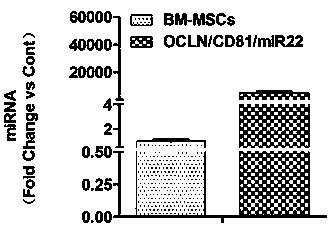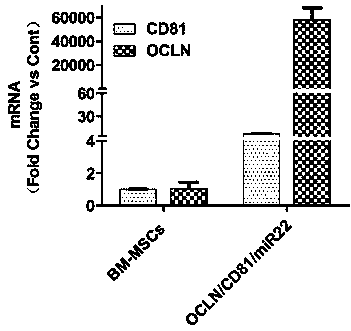Method for establishing HCV (hepatitis C virus) cell model by using tree shrew bone marrow mesenchymal stem cells
A technology of cell model and bone marrow mesenchyme, which is applied in the field of biomedicine and can solve the problems of liver cells that cannot be passaged
- Summary
- Abstract
- Description
- Claims
- Application Information
AI Technical Summary
Problems solved by technology
Method used
Image
Examples
Embodiment 1
[0042] The method for establishing the HCV cell model by utilizing tree shrew bone marrow mesenchymal stem cells comprises the following steps:
[0043] First, the tree shrew bone marrow mesenchymal stem cells were infected with the OCLN lentiviral vector, then the CD81 lentiviral vector was added to continue the infection, and then the miR-122 lentiviral vector was added for infection. After 4 hours of infection, the volume of the current culture was added. Base volume 1 / 2 of fresh medium containing 2 μg / mL polybrene, the next day, remove the old medium, replace with fresh medium to continue culturing to obtain OCLN / CD81 / miR-122-BM-MSCs; after that, HCVcc virus was inoculated in OCLN / CD81 / miR-122-BM-MSCs to obtain the HCV cell model;
[0044] The fresh medium is DMEM / F12 medium+10%FBS+100U / mL penicillin and 100μg / mL streptomycin.
Embodiment 2
[0046] The method for establishing the HCV cell model by utilizing tree shrew bone marrow mesenchymal stem cells comprises the following steps:
[0047] First add the OCLN lentiviral vector to the tree shrew bone marrow mesenchymal stem cells, mix well and put it in 37°C, 5% CO 2 After 0.5h of infection in the incubator, add the CD81 lentiviral vector, mix well and put it in 37°C, 5% CO 2 After 0.5h of infection in the incubator, the miR-122 lentiviral vector was added at the end, mixed well and placed in 37°C, 5% CO 2 Infect in the incubator for 4 hours, then add fresh medium containing 6 μg / mL polybrene with a volume equal to 1 / 2 of the current medium volume, remove the old medium on the second day, replace with fresh medium, and continue to incubate at 37°C , 5% CO 2 Cultured in an incubator to obtain OCLN / CD81 / miR-122-BM-MSCs; finally, HCVcc virus was inoculated into OCLN / CD81 / miR-122-BM-MSCs to obtain the HCV cell model.
[0048] The fresh medium is DMEM / F12 medium+10%...
Embodiment 3
[0053] The method for establishing the HCV cell model by utilizing tree shrew bone marrow mesenchymal stem cells comprises the following steps:
[0054] Resuscitated tree shrew bone marrow mesenchymal stem cells, 5×10 5 cells / mL inoculated into a 6-well plate containing fresh medium, 2mL per well, and when the cells grew to a confluence of 50% the next day, the original medium was sucked off, and the volume added was 1 / 2 of the volume of the original medium. In fresh medium containing 6 μg / mL polybrene, according to the multiplicity of infection (MOI=15), add 7.5 μL of OCLN lentiviral vector to the tree shrew bone marrow mesenchymal stem cells, mix well at 37°C, 5% CO 2 Infect in the incubator for 1h;
[0055] Afterwards, take out the cells and add 15 μL CD81 lentiviral vector, mix well and place in 37°C, 5% CO 2 Infect in the incubator for 1h;
[0056] Finally, add 7.5 μL miR-122 lentiviral vector, mix well and place in 37°C, 5% CO 2 4 hours of infection in the incubator;...
PUM
 Login to View More
Login to View More Abstract
Description
Claims
Application Information
 Login to View More
Login to View More - R&D
- Intellectual Property
- Life Sciences
- Materials
- Tech Scout
- Unparalleled Data Quality
- Higher Quality Content
- 60% Fewer Hallucinations
Browse by: Latest US Patents, China's latest patents, Technical Efficacy Thesaurus, Application Domain, Technology Topic, Popular Technical Reports.
© 2025 PatSnap. All rights reserved.Legal|Privacy policy|Modern Slavery Act Transparency Statement|Sitemap|About US| Contact US: help@patsnap.com



